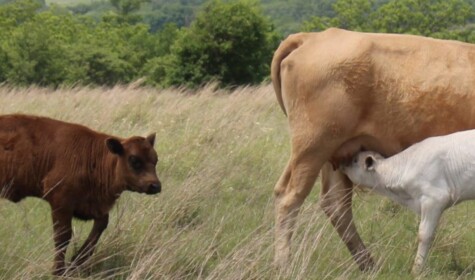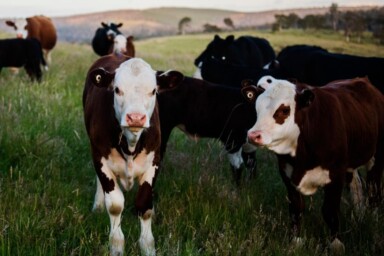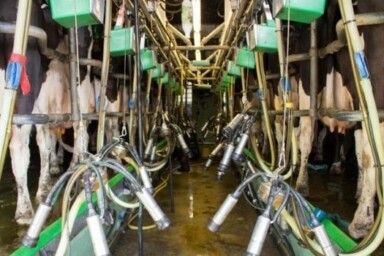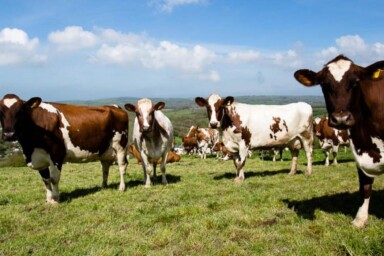As UK farming attempts to achieve ‘net zero’, there is a danger of overlooking the many ways in which agriculture interacts with nature, in a bid to drive down narrowly defined carbon emissions. The FAO’s estimate that the livestock sector generates around 14.5% of global greenhouse gas emissions has propelled livestock farming, and particularly beef farming, to the forefront of the climate change debate.
Some voices within the industry and the environmental sector are promoting the idea that livestock farming should focus on shortening lifespan, called ‘quicker finishing’, to reduce emissions. In line with this thinking, the National Beef Association last year proposed a ‘carbon tax’ for animals slaughtered above 28 months, on the basis that bringing down average slaughter age would lower British beef’s carbon footprint. Similarly, it is often suggested we should eat more chicken to lower the carbon footprint of our meat consumption – particularly the ‘fast-growing’ breeds favoured by commercial producers. The simplicity of these solutions is appealing and marketable, but by masking the complexities of the food system, they risk harming the environment further.
‘With everything else being equal indeed shorter-lived animals would have less emissions,’ says Jon Dettling, Director of Innovation and Services at Quantis, a sustainability consulting group. ‘The challenge is that these are really complicated systems.’ The type of animal, breed, diet, how active they are and where they are reared will all affect the environmental impact, says Dettling. These variables translate into a range of farming systems using very different levels of inputs, none of which is captured by finishing time. The danger of encouraging farmers to rear livestock more quickly is that they react by intensifying inputs, says Jimmy Woodrow of the Pasture for Life Association (PFLA). Inputs create emissions in myriad ways: land use changes leading to loss of carbon stores (deforestation, loss of natural grassland, soil erosion), fossil fuel-based fertiliser use, transport emissions. This is a problem on a major scale because around a third of the world’s croplands are used to grow livestock feed. ‘In reality, for us, carbon comes down to inputs,’ says Woodrow.
There are also significant non-carbon impacts of using fossil fuel and chemical inputs to speed up livestock production: water pollution, for example, and loss of biodiversity. Patrick Laurie, farmer in Galloway and author of Native: Life in a Vanishing Landscape, says it is risky to use a single measure to assess the sustainability of agriculture. Lowering carbon output through intensification can actually be ‘mutually exclusive’ to improving other measures. ‘A focus on the idea of “carbon neutral” is leading to further intensification amongst some of the big dairy industry in Galloway, and while this idea pleases the supermarkets, intensification of grassland management has annihilated all manner of farmland wildlife, particularly ground-nesting birds,’ he says.
Simplistic comparisons about whether it is more environmentally friendly to eat chicken or beef are beset by even greater complexities. ‘Chickens provide almost no ecosystem service. A ruminant can play a positive ecological impact,’ says Mr Woodrow. In mixed farming systems, ruminant grazing can recycle nutrients and re-fertilise soils, lowering chemical inputs. It also has an essential role in biodiversity promotion in many of the UK’s most important habitats such as heathland, wood pasture and coastal marshes. In addition to these well-accepted benefits, there is a growing movement championing the role of regenerative grazing in sequestering carbon in the soil, with some research suggesting this could offer significant carbon mitigation.
In contrast with a drive to intensify, Woodrow says the PFLA promotes a system based on using the positive effects of grazing to move away from the use of fertilisers, insecticides and concentrated feed. ‘You manage your grazing in a way that maximises plant regrowth, carbon sequestration and biodiversity improvements,’ he says. ‘So, if that’s the template for what we are trying to achieve then the age at slaughter is completely irrelevant. It will be farm specific; it will be soil specific.’ He believes a focus on reducing inputs is more effective in tackling emissions. ‘Farms that make this transition end up de-stocking, but [they have] a more profitable enterprise, due to lower inputs,’ he says.
Patrick Laurie’s farm embodies this approach. He has a suckler herd of Riggit Galloways which he keeps outdoors all year round. He does not buy in feed. The cattle cost him ‘almost nothing to keep’, he says, and are ‘the perfect tool’ for moorland grazing. They can digest particularly rough grass and possess an independent spirit, which means they spread out onto the hill. Their grazing delivers conservation benefits. Peat soils are formed from partially decomposed plant material under water saturated conditions; low density grazing can help promote the vegetation growth required for this process. It can also help control the onset of more invasive species, protecting biodiversity. ‘The reality is the peat has formed and is there because it has been managed as farmland,’ says Laurie. Peat is now appreciated as a hugely important carbon store; it accounts for around 3% of the earth’s terrestrial surface but may store around 21% of the total global soil organic carbon stock. The role of appropriately managed livestock grazing in its preservation, highlights just how complex the relationship between livestock and the environment is.
Farming in this way, and without buying in concentrated feed, Laurie struggles to finish in less than 30 months. This results in an additional fee at slaughter as a result of regulations introduced following the BSE outbreak. He believes adding a ‘carbon tax’ could put farmers off this low-input style of agriculture, posing a threat to Britain’s native breeds. A loss of native breeds would mean a loss of agricultural resilience, as ‘each breed excels at something different,’ he says. At a time of increasing climatic instability, losing this diversity could prove a fatal mistake.
‘There is an argument that climate change supersedes every other concern,’ says Laurie, but he sees risks in trying to pull apart highly interconnected issues like biodiversity, soil management and carbon sequestration. ‘You cannot overestimate the connectedness of nature,’ he says.
Jimmy Woodrow says ‘silo thinking’ about the environment is what led us to this point; it is unlikely to lead us out of it. Farmers reducing input use and moving towards ecologically managed grazing are getting excited about the benefits, he says, not only on biodiversity and soil health but also carbon sequestration, which remains the most contested area. But they face barriers in becoming more than a niche industry. Unlike further intensification to achieve incremental reductions in the output of emissions, low input farming requires a wholesale change in consumers’ diet and purchasing as well as a radical change in food production and distribution. It will also be an uphill battle to counter simplistic arguments about livestock emissions, which the public have heard so consistently for so long. Fortunately, farmers are becoming bolder in talking about how farming has changed in recent decades; how an over-reliance on chemicals has made their businesses financially and environmentally fragile, and how they are trying to address this. The danger is that these voices are overlooked in the search for simple solutions to the genuinely urgent problem of greenhouse gas emissions.
Photograph: SMBAphotography







